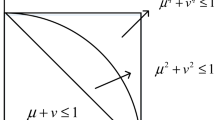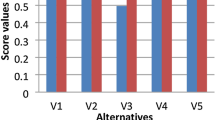Abstract
The q-rung orthopair fuzzy line integral (q-ROFLI) operator is a potent mathematical tool to aggregate non-standard fuzzy information in the process of Decision Making. To overcome some disadvantages of the q-rung orthopair fuzzy integral curves (q-ROFICs) which was proposed by Gao et al. (IEEE Trans Cybern, https://doi.org/10.1109/TCYB.2019.290865, 2019), in this paper, we present a novel definition of q-ROFICs. Based on this notion, we give a completed definition for q-ROFLI. Furthermore, we give a Newton–Leibniz formula through the q-rung orthopair fuzzy function with the variable upper limit (VUL-q-ROFF), and investigate the intermediate value theorem which can be utilized to solve generalized mean value theorem. Moreover, we propose the q-rung orthopair fuzzy line integral aggregation (q-ROFLIA) operator, and an improved q-ROFLIA with reliability (R-q-ROFLIA) operator. As their applications, we give several examples to show the process for aggregating q-rung orthopair fuzzy data by these operators. At last, the validity and flexibility of the above operators are verified through a practical example, especially the superiority of R-q-ROFLIA can avoid losing important extreme data, and make the results more suitable for the practical Decision Making.














Similar content being viewed by others

References
Akram M, Davvaz B (2012) Strong intuitionistic fuzzy graphs. Filomat 26(1):177–196
Atanassov KT (1986) Intuitionistic fuzzy sets. Fuzzy Sets Syst 20(1):87–96
Boran FW, Gen S, Kurt M, Akay D (2009) A multi-criteria intuitionistic fuzzy group decision making for supplier selection with TOPSIS method. Expert Syst Appl 36(8):11363–11368
Chen CT (2000) Extensions of the TOPSIS for group decision-making under fuzzy environment. Fuzzy Sets Syst 114(1):1–9
Chen SM, Tan JM (1994) Handling multicriteria fuzzy decision-making problems based on vague set theory. Fuzzy Sets Syst 67(2):163–172
Gao J, Liang Z, Shang J, Xu ZS (2018) Continuities, derivatives and differentials of q-rung orthopair fuzzy functions. IEEE Trans Fuzzy Syst. https://doi.org/10.1109/TFUZZ.2018.2887187
Gao J, Liang ZL, Xu ZS (2019) Additive integrals of q-rung orthopair fuzzy functions. IEEE Trans Cybern. https://doi.org/10.1109/TCYB.2019.290865
Grabisch M, Orlovski SA, Yager RR (1998) Fuzzy aggregation of numerical preferences. In: Roman S (eds) Fuzzy sets in decision analysis, operations research and statistics. Springer, Boston, MA, pp 31–68
Hong DH, Choi CH (2000) Multicriteria fuzzy decision-making problems based on vague set theory. Fuzzy Sets Syst 114(1):103–113
Lei Q, Xu ZS (2014) Derivative and differential operations of intuitionistic fuzzy numbers. Int J Intell Syst 30:468–498
Lei Q, Xu ZS (2015) Fundamental properties of intuitionistic fuzzy calculus. Knowl Based Syst 76:1–16
Lei Q, Xu ZS, Bustince H, Burusco A (2015) Definite integrals of Atanassov’s intuitionistic fuzzy information. IEEE Trans Fuzzy Syst 23(5):1519–1533
Liu P, Wang P (2018) Some q-rung orthopair fuzzy aggregation operators and their applications to multiple-attribute decision making. Int J Intell Syst 33:259–280
Liu P, Chen S, Wang P (2018) Multiple-attribute group decision-making based on q-rung orthopair fuzzy power Maclaurin symmetric mean operators. IEEE Trans Syst Man Cybern Syst. https://doi.org/10.1109/TSMC.2018.2852948
Parvathi R, Karunambigai MG (2006) Intuitionistic fuzzy graphs. In: 6th International conference on computational intelligence, theory and applications; advances in soft computing, Dortmund(DE), Germany, pp 139–150
Peng X, Yang Y (2016) Pythagorean fuzzy Choquet integral based MABAC method for multiple attribute group decision making. Int J Intell Syst 31:989–1020
Peng X, Dai J, Garg H (2018) Exponential operation and aggregation operator for q-rung orthopair fuzzy set and their decision-making method with a new score function. Int J Intell Syst 33:2255–2282
Shu XQ, Ai ZH, Xu ZS, Ye JM (2019) Integrations of q-rung orthopair fuzzy continuous information. IEEE Trans Fuzzy Syst. https://doi.org/10.1109/TFUZZ.2019.2893205
Sugeno M (1974) Theory of fuzzy integral and its application (Doctoral dissertation). Tokyo Institute of Technology. Tokyo, Japan
Xing Y, Zhang R, Zhou Z (2019) Some q-rung orthopair fuzzy point weighted aggregation operators for multi-attribute decision making. Soft Comput. https://doi.org/10.1007/s00500-018-03712-7
Xu ZS (2007) Intuitionistic fuzzy aggregation operators. IEEE Trans Fuzzy Syst 15(6):1179–1187
Xu ZS, Yager RR (2006) Some geometric aggregation operators based on intuitionistic fuzzy sets. Int J Gen Syst 35(4):417–433
Yager RR (2014) Pythagorean membership grades in multicriteria decision making. IEEE Trans Fuzzy Syst 22(4):958–965
Yager RR (2017) Generalized orthopair fuzzy sets. IEEE Trans Fuzzy Syst 25(5):1222–1230
Ye J (2010) Fuzzy decision-making method based on the weighted correlation coefficient under intuitionistic fuzzy environment. Eur J Oper Res 205(1):202–204
Zadeh LA (1965) Fuzzy sets. Inf Control 8:338–353
Acknowledgements
The authors would like to thank the referees for their invaluable suggestions, which put the article in its present shape. Also, the authors are thankful to the NICE: NRT for Integrated Computational Entomology, US NSF award 1631776.
Funding
This work was supported by the National Natural Science Foundation of China under Grant Nos. 61806030, 61936001 and 61876201. The National Key Research and Development Program of China under Grant No. 2019QY(Y)0301. The Natural Science Foundation of Chongqing under Grant Nos. cstc2019jcyjmsxmX0485 and cstc2019jcyj-cxttX0002.
Author information
Authors and Affiliations
Contributions
YS contributed to the data analysis work and checked the whole manuscript. JZ performed the simulations and wrote this manuscript. All authors revised and approved the publication.
Corresponding author
Ethics declarations
Conflict of interest
The authors declare that they have no known competing financial interests or personal relationships that could have appeared to influence the work reported in this paper.
Human participants or animals
This article does not contain any studies with human participants or animals performed by any of the authors.
Additional information
Publisher's Note
Springer Nature remains neutral with regard to jurisdictional claims in published maps and institutional affiliations.
Rights and permissions
About this article
Cite this article
Shao, Y., Zhuo, J. Improved q-rung orthopair fuzzy line integral aggregation operators and their applications for multiple attribute decision making. Artif Intell Rev 54, 5163–5204 (2021). https://doi.org/10.1007/s10462-021-10017-z
Accepted:
Published:
Issue Date:
DOI: https://doi.org/10.1007/s10462-021-10017-z



